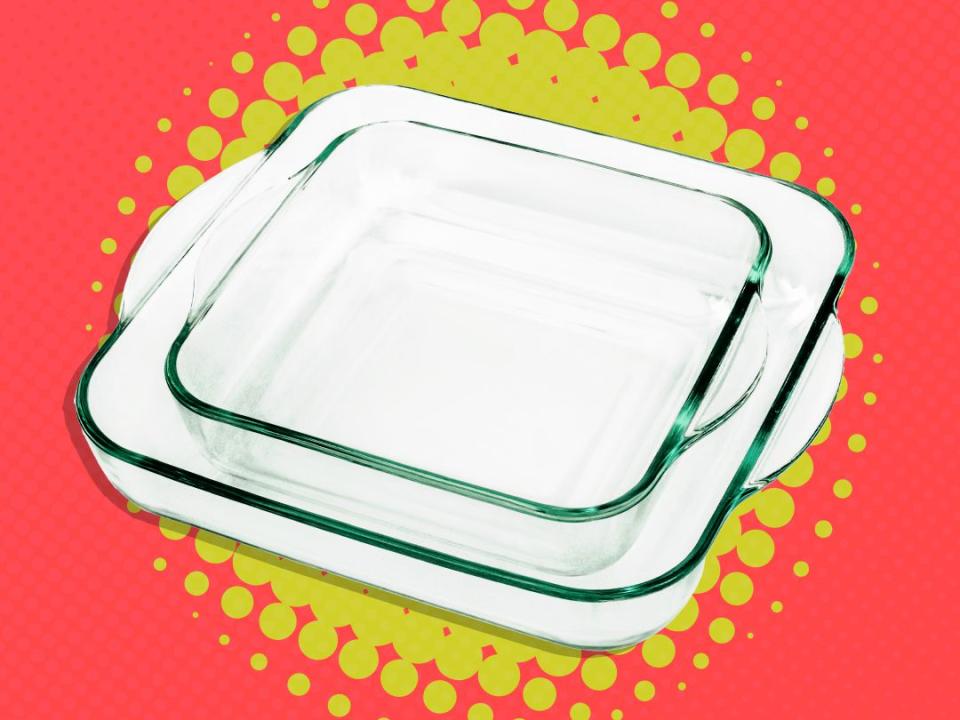If Pyrex Isn't Safe Anymore, Which Brand of Glass Bakeware Should You Buy?
We did some digging and found an answer!

Getty Images/Allrecipes
Looking for a glass bakeware set that is durable, easy to clean, and safe shouldn't be rocket science, but not all glassware is created equally. Certain glass bakeware can crack or even shatter at moderate to high temperatures, causing burns, cuts, or other serious injuries. Knowing what type of glass will hold up best to high heat from your oven is essential to picking out the brand that's right for baking the best casseroles, quick breads, and coffee cakes.
What are the different types of glass for bakeware?
There are three basic types of glassware: soda-lime, tempered, and borosilicate.
Soda-lime glass is the most common glass type in kitchens, found in cups and jars, and is more susceptible to breaking from extreme temperature changes, and therefore is not a good option for the heat tolerance required of bakeware.
Tempered glass is actually heat-treated soda-lime glass. The heat treatment makes it more durable, but it’s not as resilient to temperature shifts, like what occurs when moving a casserole dish from the fridge to the oven, as borosilicate glass.
Borosilicate glass is made with boron trioxide, which has a low thermal expansion, meaning it won't break when exposed to major temperature shifts.
What is the safest glass for baking?
Because borosilicate is the most durable when it comes to withstanding temperature changes, it is generally considered the safest choice for glass bakeware. When it comes to purchasing new or used glass bakeware, it’s important to pay close attention to labels, since some brands, like Pyrex and Anchor Hocking once used borosilicate but now use tempered glass.
What should I look for when I shop for glass bakeware?
If you're determined to have the strongest stuff out there, consider purchasing from a brand still making glassware out of borosilicate, such as OXO. These bakeware dishes and glass meal prep containers come with or without lids in a variety of sizes for all kinds of food storage needs. They also make recognizable and resilient non-glass measuring cups.
If you’re considering buying Pyrex bakeware, look for the label in all-uppercase letters (PYREX), which generally indicates it is made with borosilicate glass.
Is borosilicate glass bakeware more expensive?
A bakeware set, as well as individual baking dishes, made with borosilicate are typically going to be pricier than cookware made with other glass, so look for sales or coupons to help lower the price. But keep in mind that borosilicate bakeware should be higher in quality as well. It doesn't hurt to search local antique shops for a lucky vintage Pyrex find or two, but don’t hesitate to treat yourself to a new set if top-notch quality is your thing.
What are some basic safety rules when cooking with glass bakeware?
Always make sure to read about proper handling, heating, cleaning, and storage of glass products to avert dinner disaster. Avoid putting hot dishes directly onto wet countertops or countertops without trivets. Another tip for preventing glassware from cracking is to avoid transferring glass dishes directly from the fridge to the oven and vice versa. Give your dishes time to reach room temperature. Remember: rapid changes in temperature will make the glass expand or contract, potentially resulting in breakage or damage to the dish. And when your dish has come out hot from the oven, been savored around the table, and the leftovers cooled and stored in the fridge for a lucky recipient, here’s how to make your prized glass bakeware shiny and clean as new.

